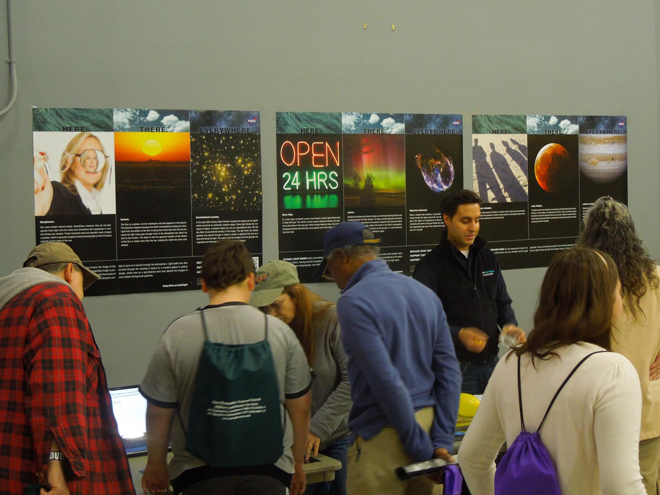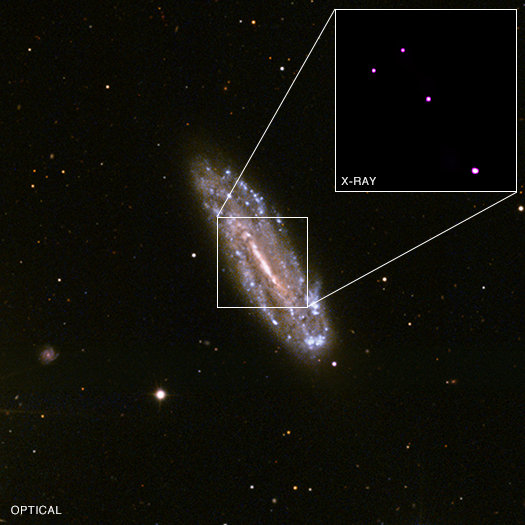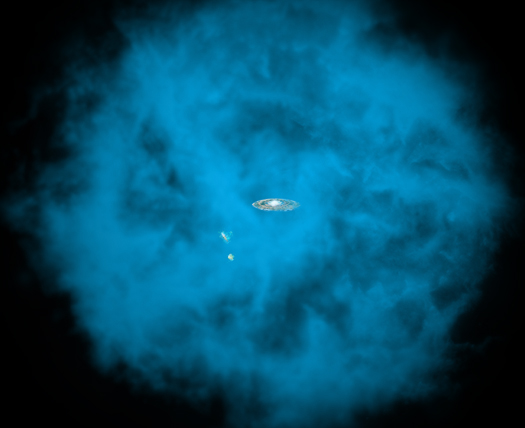Spirals Everywhere
This week's Hurricane Sandy got us thinking about spirals. Most of us have seen images of hurricanes from above – either photos from airplanes or radar taken with satellites.

Look Back Time -- Remembering Franco
The finite speed of light means that we must always be out of date, no matter how hard we strive to keep up with the times. The term look-back time refers to the time in the past when the light we now observe from a distant object was emitted. For example, deep Chandra observations have detected X-rays that have been travelling through intergalactic space for billions of years since they were emitted by jets of gas that were likely produced by rotating supermassive black holes. With these data, astronomers use Chandra and other telescopes as one-way time machines that enable them to see objects as they were in the past.
Revealing a Mini-Supermassive Black Hole
One of the lowest mass supermassive black holes ever observed in the middle of a galaxy has been identified, thanks to NASA's Chandra X-ray Observatory and several other observatories. The host galaxy is of a type not expected to harbor supermassive black holes, suggesting that this black hole, while related to its supermassive cousins, may have a different origin.
Mission to the Universe: Stars and Stripes Family Fest

The NH National Guard Child and Youth Program and NHNG Military Education Outreach Committee were proud to present a pilot science event with the Chandra Education & Outreach Group on October 14, 2012 in Concord, New Hampshire. The Mission to the Universe – Stars and Stripes Family Fest provided family friendly science activities from Chandra such as the "Here, There, and Everywhere" project, "STOP for Science" and the "Universe in a Jelly Bean Jar". Chandra science imager Joe DePasquale was on hand to demonstrate the concept of lensing to visitors and talk about how Chandra images are made. Chandra educator Donna Young discussed the life and death of stars.
A Planetary Nebula Gallery
This gallery shows four planetary nebulas from the first systematic survey of such objects in the solar neighborhood made with NASA's Chandra X-ray Observatory. The planetary nebulas shown here are NGC 6543, also known as the Cat's Eye, NGC 7662, NGC 7009 and NGC 6826. In each case, X-ray emission from Chandra is colored purple and optical emission from the Hubble Space Telescope is colored red, green and blue.
Answering Two Popular Questions About That Hot Gas

In writing a press release, a major goal is to present the truth, and nothing but the truth. However, it isn't practical to present the whole truth. For example, the paper associated with our press release last week was only six pages long, but contained 38 references to other papers, and each of these papers contain many more references. This is how research advances, building incrementally on previous work. Since we have limited space in a press release we cannot present the whole truth and we only include the information that we think is crucial for explaining the result and its significance.
Milky Way is Surrounded by Huge Halo of Hot Gas
This artist's illustration shows an enormous halo of hot gas (in blue) around the Milky Way galaxy. Also shown, to the lower left of the Milky Way, are the Small and Large Magellanic Clouds, two small neighboring galaxies (roll your mouse over the image for labels). The halo of gas is shown with a radius of about 300,000 light years, although it may extend significantly further.
A Space Jigsaw Puzzle: Coordinating Chandra With Other Telescopes
In July 2012, an event took place that gives us a chance to talk about several important aspects of Chandra observations involving coordination with other observatories, how they are done, and how they fit into the bigger picture of astronomical research.

Coordinated observations are those that must be done by Chandra and one or more other observatories at approximately the same time. Astronomers often want to study objects with multiple observatories because their different capabilities --- especially in detecting different regions of the electromagnetic spectrum --- can provide insight that no single observatory can do alone. The need for coordination in time comes because so many objects in space vary over time. That means that observations taken too far apart could be less valuable because the object has changed substantially in the meantime. It's often important for all observatories involved to catch the object during a particular celestial event. In the current annual cycle, Chandra's 13th , for example, about 10% of the approved observations request coordination with another observatory.
Was Kepler's Supernova Unusually Powerful?
In 1604, a new star appeared in the night sky that was much brighter than Jupiter and dimmed over several weeks. This event was witnessed by sky watchers including the famous astronomer Johannes Kepler. Centuries later, the debris from this exploded star is known as the Kepler supernova remnant.
Astronomers have long studied the Kepler supernova remnant and tried to determine exactly what happened when the star exploded to create it. New analysis of a long observation from NASA's Chandra X-ray Observatory is providing more clues. This analysis suggests that the supernova explosion was not only more powerful, but might have also occurred at a greater distance, than previously thought.
Going Back to School
This week marks the return to school for most kids (if they haven't been there for a week or more already). The post-Labor Day week got us thinking about school and education as it relates to Chandra and X-ray astrophysics.






